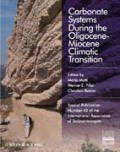
Carbonate systems during the Olicocene-Miocene climatic transition: special publication 42 of the IAS
Mutti, Maria
Piller, Werner E.
Betzler, Christian
The Oligocene and Miocene Epochs comprise the most important phases in the Cenozoic global cooling that led from a greenhouse to an icehouse Earth. Recent major advances in the understanding and time-resolution of climate events taking place at this time, as well as the proliferation of studies on Oligocene and Miocene shallow-water/neritic carbonate systems, invite us to re-evaluate the significance of these carbonate systems in the context of changes in climateand Earth surface processes. Carbonate systems, because of a wide dependence on the ecological requirements of organisms producing the sediment, are sensitive recorders of changes in environmental conditions on the Earth surface. Thepapers included in this Special Publication address the dynamic evolution of carbonate systems deposited during the Oligocene and Miocene in the context onclimatic and Earth surfaces processes focusing on climatic trends and controls over deposition; temporal changes in carbonate producers and palaeoecology; carbonate terminology; facies; processes and environmental parameters (including water temperature and production depth profiles); carbonate producers and their spatial and temporal variability; and tectonic controls over architecture INDICE: Miocene carbonate systems: an introduction (M. Mutti, W. Piller and C. Betzler). 1. A synthesis of Late Oligocene through Miocene deep sea temperatures as inferred from foraminiferal Mg/Ca Ratios (K. Billups and K. Scheiderich). 2. Latitudinal trends in Cenozoic reef patterns and their relationship to climate (C. Perrin and W. Kiessling). 3. Carbonate grain associations: their use and environmental significance, a brief review (P. Kindler and M. Wilson). 4. Temperate and tropical carbonatesedimentation episodes in the Neogene Betic basins (southern Spain) linked to climatic oscillations and changes in Atlantic-Mediterranean connections: constraints from isotopic data (J. M. Martin,J. C. Braga, I. M. Sanchez-Almazo and J. Aguirre). 5. Facies models and geometries of the Ragusa Platform (SE Sicily, Italy) near the Serravallian-Tortonian boundary (C. Ruchonnet and P. Kindler). 6. The sensitivity of a tropical foramolrhodalgal carbonate ramp to rapid sea-level change: Miocene of the centralApennines, Italy (M. Brandano, H. Westphal and G. Mateu-Vicens). 7. Facies and sequence architecture of a tropical foramol-rhodalgal carbonate ramp: Miocene of the central Apennines (Italy) (M. Brandano, L. Corda and F. Castorina). 8. Facies and stratigraphic architecture of a Miocene warm-temperate to tropical fault-block carbonate platform, Sardinia (Central Mediterranean Sea) (M.-F. Benisek, G. Marcano, C. Betzler and M. Mutti). 9. Coralline algae, oysters andechinoids - a liaison in rhodolith formation from the Burdigalian of the Latium-Abruzzi Platform (Italy) (M. Brandano and W. E. Piller). 10. Palaeoenvironmental significance of Oligocene-Miocene coralline red algae - a review (J. C. Braga, D. Bassi and W. E. Piller). 11. Molluscs as a major part of subtropicalshallow-water carbonate production - an example from a Middle Miocene oolite-shoal (Upper Serravallian, Austria) (M. Harzhauser and W. E. Piller). 12. Echinoderms and Oligo-Miocene carbonate systems: potential applications in sedimentology and environmental reconstruction (A. Kroh and J. H. Nebelsick). 13. Coral diversity and temperature: a palaeoclimatic perspective for the Oligo-Miocene of the Mediterranean region (F. R. Bosellini and C. Perrin). 14. Late Oligocene to Miocene reef formation on Kita-daito-jima, northern Philppine Sea (Y. Iryu, S. Inagaki, Y. Suzuki and K. Yamamoto). 15. Carbonate production in riftbasins: models for platform inception, growth and dismantling, and for shelf to basin sediment transport, Miocene Sardinia Rift Basin, Italy (M. Vigorito, M. Murru and L. Simone).
- ISBN: 978-1-4443-3791-4
- Editorial: Wiley-Blackwell
- Encuadernacion: Cartoné
- Páginas: 312
- Fecha Publicación: 24/09/2010
- Nº Volúmenes: 1
- Idioma: Inglés
